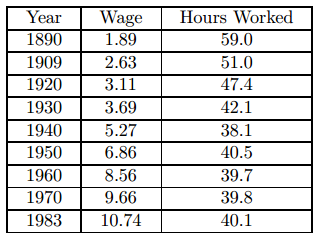In the United States, real wage rates in manufacturing have risen steadily from 1890 to the present.
Question:
In the United States, real wage rates in manufacturing have risen steadily from 1890 to the present. In the period from 1890 to 1930, the length of the workweek was reduced dramatically. But after 1930, despite the continuing growth of real wage rates, the length of the work week has stayed remarkably constant at about 40 hours per week.
Hourly Wages and Length of Work Week
in U.S. Manufacturing, 1890–1983.

(a) Use these data to plot a “labor supply curve” on the graph below.
(b) At wage rates below $4 an hour, does the workweek get longer or shorter as the wage rate rises?
(c) The data in this table could be consistent with workers choosing various hours a week to work, given the wage rate. An increase in wages has both an endowment income effect and a substitution effect. The substitution effect alone would make for a (longer, shorter) ____________ workweek. If leisure is a normal good, the endowment income effect tends to make people choose (more, less) _________ leisure and a (longer, shorter) __________ workweek. At wage rates below $4 an hour, the (substitution, endowment income) ____________ effect appears to dominate. How would you explain what happens at wages above $4 an hour?
(d) Between 1890 and 1909, wage rates rose by ________ percent, but weekly earnings rose by only ______ percent. For this period, the gain in earnings (overstates, understates) ___________ the gain in workers’ wealth, since they chose to take (more, less) _____________ leisure in 1909 than they took in 1890.
Step by Step Answer:






